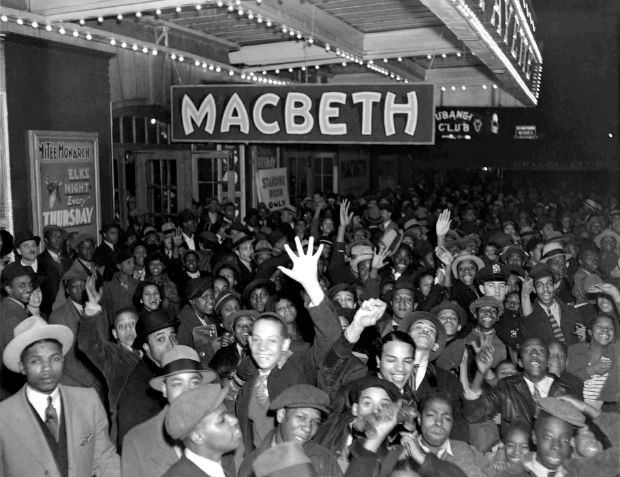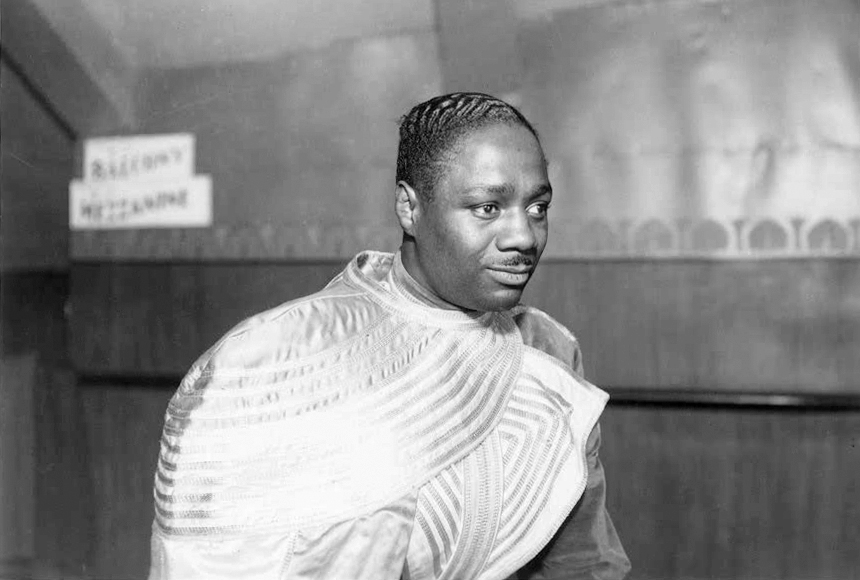 For days, Harlem residents strolling anywhere between Lexington Avenue and Broadway from 125th to 140th Streets had seen the word “Macbeth” for Orson Wells stenciled in glowing paint at every corner.
For days, Harlem residents strolling anywhere between Lexington Avenue and Broadway from 125th to 140th Streets had seen the word “Macbeth” for Orson Wells stenciled in glowing paint at every corner.
The Harlem community had been discussing the new production by the Federal Theater Project’s Negro Unit with mingled pride and anxiety for months, and by opening night on April 14, 1936, anticipation had reached a fever pitch.
At 6:30 p.m., 10,000 people stood as close as they could come to the Lafayette Theater on Seventh Avenue near 131st Street, jamming the avenue for 10 blocks and halting northbound traffic for more than an hour.
Spotlights swept the crowd as mounted policemen strove to keep the entrance to the theater open for the arriving ticket holders, an integrated group of “Harlemites in ermine, orchids and gardenias, Broadwayites in mufti,” as the New York World-Telegram noted the next day.
Every one of the Lafayette’s 1,223 seats was taken; scalpers were getting $3 for a pair of 40-cent tickets. The lobby was so packed people couldn’t get to their seats; the curtain, announced for 8:45, didn’t rise until 9:30. When it finally did, on a jungle scene complete with witches and voodoo drums, the frenzied mood outside the theater was matched by that within.
“Excitment…fairly rocked the Lafayette Theatre,” The New York Times commented the next morning. The spectators were enthusiastic and noisy; they vocally encouraged Shakespeare’s Macbeth’s soliloquies and clapped vigorously when the second act opened with more than half of the 100-plus cast massed onstage for his coronation ball, a sea of colorful costumes swaying to the strains of Joseph Lanner waltzes.

After the curtain fell on the final grim tableau of the witches holding Macbeth’s severed head aloft as Hecate intoned ominously, “The charm’s wound up!” cheers and applause filled the auditorium for 15 minutes. Not bad for a show directed by an actor barely out of his teens with a cast that was 95 percent amateur, and a scenery and costume budget of $2,000. The overture was by James P. Johnson and such notable actors as Canada Lee (above) and Rose McClendon were part of the program.
The “Voodoo Macbeth,” as this all-black version set in 19th century Haiti came to be called, was notable on several counts. It was one of four Manhattan premieres in the spring of 1936 that solidified the shaky reputation of the Federal Theater Project, the most controversial of the Works Progress Administration’s arts programs. The project had been under fire since its founding in August 1935 for spending taxpayers’ money on salaries without actually providing much theater for the public to see.
Macbeth launched the meteoric directing career of Orson Welles, not yet 21 when it opened, who would go on to astonish New York theatergoers with several more bold stage productions before departing for Hollywood in 1939. It gave African-American performers, usually restricted to dancing and singing for white audiences, a chance to prove they were capable of tackling the classics (source).
Become a Harlem Insider!
By submitting this form, you are consenting to receive marketing emails from: . You can revoke your consent to receive emails at any time by using the SafeUnsubscribe® link, found at the bottom of every email. Emails are serviced by Constant Contact








